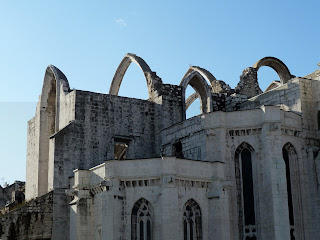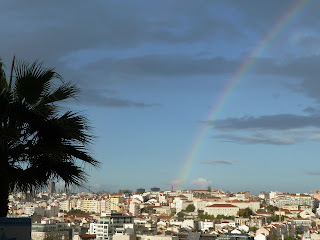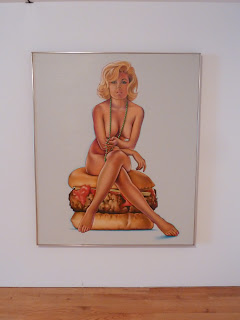We arrived in torrential rain to get a taxi and promptly found our arrival had coincided with a Benfica Champions League home game, so progress was a little slow. Our driver opened the side window a little to reduce the condensation caused by a car-load of pension lawyers. Unfortunately at this point a juggernaut passed in the opposite direction through a large puddle, the contents of which it managed to deposit through the open window and into the lap of an eminent pensions barrister, somewhat to his surprise. Welcome to Lisbon.
I won't give you an account of the conference, nor pictures (Imagine 250 people in a hall listening to lectures. Yes, you have got the picture without needing to trouble the old digital camera). But we do by tradition have a black tie dinner on the Thursday evening, so if you want to see my firm's delegation dressed up for the occasion, well here we are.
A rather nice venue too, and old tram building. Lit almost entirely by candles with a few uplighters. And a bar with dance floor afterwards.
Ok, but outside the conference, what is there to see in Lisbon? Well first, at least in terms of proximity to the conference hotel, is the Gulbenkian museum. I confess I had a spot of bother finding the place, not helped by there being no picture of the actual building in my guidebook. When I did find it I realised why. Its one of those very unlovable post-war efforts in the style of our own South Bank centre. No amount of planting and water can quite disguise its innate ugliness.
But the collection is very high quality and reflects to the tastes of the Armenian financier who put it together. So it has its ancient artifacts, especially gold coins and medallions,
a large Islamic collection,


an extensive collection of 18th century French furniture (rather over exuberant for modern tastes one feels),

a very fine collection of paintings from the renaissance to the impressionists and finishing off with room full of Lalique jewellery.

I also popped into the design museum which apart from anything else had conveniently late opening hours. It had the usual collection of alarmingly impractical looking chairs which could only be designed by chiropractors seeking extra business. But there was some nice 20th century glassware if you like Scandinavian glass (and guess what? I do.)
Lisbon at night is rather nice, or at least the district I was staying in. Large squares (ok, a bit rectangular) with fountains and wide streets, all well illuminated. If very skilled you can even get past the line-up of waiters trying to entice you into their fish restaurants. A modern variation on running the gauntlet.
Saturday morning I decided to buy a two day ticket for an open-topped bus route where one can get on and off as often as you like, as well as get a commentary on the sites you pass. And indeed as I left the hotel I was cursing myself for having left behind my sunglasses such was the low but bright sunshine. But it didn't last long. Remember that forecast for thundery showers?
Lisbon used Expo 98 (and the 500th anniversary of Vasco da Gama reaching India) to regenerate a bit of industrial coastline, producing the Parque de Nacoes (or Park of Nations if you prefer). All quite impressive, but the main feature is one of the world's largest aquariums, Ocenario. Now there are many reasons why you might want to visit this, an interest in ecology, love of animals, somewhere to take the kids. For me it was the opportunity to get my trousers dry. Top of an open-top bus isn't the best place in the rain, and a shower-proof jacket can only do so much. I figured this was the first warm dry place I could stop at.
And it was very impressive. I have been to equivalents in Cape Town and Brest, but this was the neatest designed. It has a huge central tank which you can see from various angles and depths, lots of small tanks for particular creatures like sea-anemones or sea-horses, but most strikingly, the surface conditions of the shoreline of various seas, the Atlantic, Pacific, Indian and Antarctic. Lets face it there aren't too many more photogenic creatures than puffins,
unless its the penguins,
but even they are all outdone by sea-otters.
The rest just need to fight amongst themselves for attention. (By the way, there are lots of fast darting colourful fish, but fast motion and low-light do not make for good photographs. Just a blur.)
Like Rome and Istanbul, Lisbon is built on seven hills. Which gives some great views,
but also some very steep climbs. One way of travelling up the hills is using little funicular railways.
But another, at one particular place, is literally to take the elevator - the elevador de Santa Justa.
At the top is the Bairro Alto (the upper town to you) and the Convento do Carmo. This was partially destroyed by an earthquake in 1755 (along with much of the rest of the city) but this was a lucky break as it makes an impressive ruin and if complete they would only be working out what to do now with a redundant convent in the city. There are only so many art centres and museums you can have. As it is, it does host a small archaeological museum with a collection of this and that, including two mummified Peruvian children (pretty gruesome and not for family viewing).
In the by now glorious sunshine, the blue sky being a perfect background to the bleached limestone of the ruins, I proceeded to wander further into the upper town, including a church which was just about to host rehearsals for a classical concert, and so echoed to opera singers practising their scales and people rushing around with props.
But with the prevailing weather conditions being showery, by the time I had made the next major viewpoint, it was raining again. Of course if you mix rain and sunshine you sometimes get a rainbow. So I got a few snaps of Lisbon under a rainbow. Neat eh?
On Sunday I headed out to the Belem area (home of Belenenses, Lisbon's third football team after Sporting and Benfica, but you knew that didn't you?). Now this area has much to recommend it - nice parks between the River Tagus and the main buildings, a very pink Presidential Palace, a coach museum... Oh yes I had to visit the coach museum. Not too promising you might think, but I had, remember, just gone to see a museum for a lot of pots in Stoke-on Trent the weekend before. I have even been to a rice growing museum in my time, so the somewhat specialist nature of the exhibits didn't put me off. (Lisbon also has an Electricity Museum, but I drew the line at that. After all, isn't electricity invisible?). Actually an impressive building with lots of coaches (and Berlins, chases, sedan chairs and lots of other coach offshoots for the connoisseur). Most wonderfully elaborate and tasteless. Guess who had the most lavish, overwrought coach, replete with gilded carvings of scantily clad youths? Marie-Antoinette perhaps, or the Sun King? No think of someone on an altogether different level of moral degeneracy and tasteless bling. Yes you got it. The Pope. Knew you could get there if you tried.
But for sheer quirkiness I rather liked the 21st century blue "bubble" sedan chair. For when a Ferrari just seems a little too common and altogether too fast..
However, the main reason to visit the area is the huge Mosteiro dos Jeronimos.
This time not a ruined monastery, so it has had to find things to be used for in the modern era So it includes an archaeological museum and a maritime museum. By far the most exciting parts are the cloisters with their elaborate carvings.
Of course, the attaching church is hardly understated either.
The other main tourist trap here is the Torre de Belem, a sixteenth century fortified tower. Regrettably not built for the number of tourists who want to go up its tiny spiral staircase for the views from the top.
And a special exhibition of the works of Victor Muniz, who makes pictorial images out of much smaller objects, like this western scene made out of tiny plastic toy soldiers and horses. Cool.
Anything else? Well yes lots really, so here are a few random shots of things in passing.


































































































































































No comments:
Post a Comment